GeIL Evo Veloce Review: 2x8GB at DDR3-2400 C11-12-12 1.65 V
by Ian Cutress on October 24, 2012 5:50 PM EST- Posted in
- Memory
- Ivy Bridge
- DDR3
- GeIL
As part of a series of memory reviews, the next kit to enter our test beds is a limited edition enthusiast kit from GeIL. Attached with what is called a ‘Frost White’ colored heatsink, this is a two module dual channel kit with a total of 16 GB running at DDR3-2400 MHz at 11-12-12-30 sub-timings that retails for ~$150.
GeIL: The Company
GeIL is short for Golden Emperor International Limited, and in the world of memory, have been a main player in the consumer memory space since the late 1990s. Today their product range consists of product names typically reserved for cars – Corsa, Leggera, and in this case Evo Veloce. This could imply that GeIL want to advertise themselves at the forefront of memory production, and this is shown by their catalogue on Newegg showcasing mostly kits with 8GB modules.
The bulk of their memory sales comes from their Corsa range, featuring yellow colored heatsinks in a range of capacities (8GB modules to 8x8GB kits) and speeds (1333 to 2133 MHz).
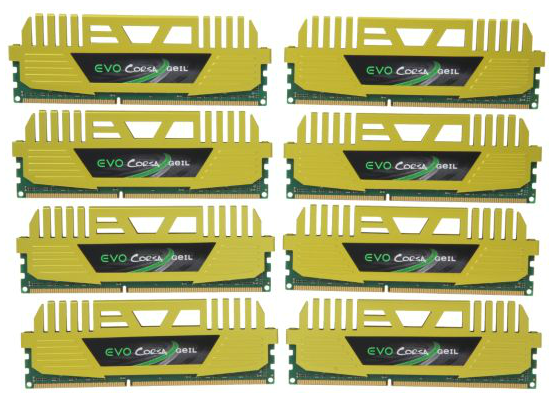
The Leggera range has similar speeds (up to 2400 MHz) and capacities (up to 4x8GB kits), but smaller blue heatsinks.

In contrast their Black Dragon range is heatsinkless, and comes in at only 1333 and 1600 MHz:
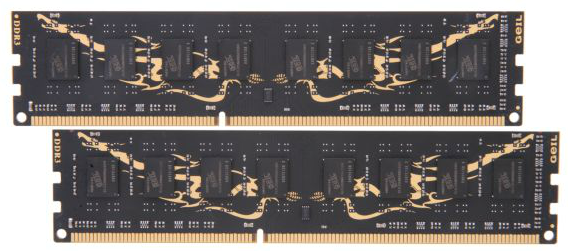
Today we are looking at one of GeIL’s Evo Veloce kits, kitted out in a ‘limited edition’ frost white. The heatsinks are large, and with two 8 GB modules, there leaves room for upgrades in the future.
GeIL Evo Veloce DDR3-2400 11-12-12 2x8GB Kit Overview
Back in the 'DDR3 on Ivy Bridge' overview, superlatives were not forthcoming with our DDR3-2400 C10 kit under scrutiny. It offered little performance gain over the DDR3-2133 C9 kit, but asked for another $15 for the privelege to exceed in peak synthetic results only. The GeIL Evo Veloce DDR3-2400 11-12-12 2x8GB kit then has a tough act to follow, coming in at $150 (more than the 2400 C10 kit) and having the timings reduced. The upshot of all this is more capacity per module, leaving the door open for future upgrades, or maximising the memory in a dual module system.
When making the jump from 4GB modules to 8GB modules, compromises have to be made. It could be construed that as everything is smaller, accesses should be quicker – but with double the density we can accrue additional latencies by reading larger rows in our memory module. Whether that actually makes a difference in normal day to day tasks is another matter – everything to do with memory and memory speed borders on the debatable when it comes to actually affecting everyday use.
In terms of the competition, solely looking at 2x8 GB kits means on Newegg we have two competitors – the G.Skill TridentX 2400 C10 kit ($155) and the Corsair Dominator Platinum 2400 C10 kit ($255). Going on solely XMP profiles, the G.Skill is the main competition, and being C10 is an advantage. However, a set of 2x8 GB from the Crucial Ballistix range at 1866 C9 ($150) could also give the 2400 kit a run for the money. Based on the calculation methods described in our original Ivy Bridge DDR3 overview, we having the following:
2x8GB DDR3-2400 C10 has a latency of 8.33ns, and will read 8 words in 11.25ns
2x8GB DDR3-2400 C11 has a latency of 9.16ns, and will read 8 words in 12.08ns
2x8GB DDR3-1866 C9 has a latency of 9.65ns, and will read 8 words in 13.40ns
Whenever we look for a memory kit, having something extra to talk about always helps – aesthetics or overclocking usually works well. While the Evo Veloce frost white modules look nice, they overclocked relatively well, hitting 1T with no issues, as well as overclocking to DDR3-2600 11-12-12 and DDR3-2400 10-11-11 at stock voltages.
Specifications
| G.Skill | GeIL | G.Skill | ||||
| Kit Speed | 1333 | 1600 | 1866 | 2133 | 2400 | 2400 |
| Subtimings | 9-9-9-24 2T | 9-9-9-24 2T | 9-10-9-28 2T | 9-11-10-28 2T | 11-12-12-30 2T | 10-12-12-31 2T |
| Price | $75 | $80 | $95 | $130 | $150 | $145 |
| XMP | No | Yes | Yes | Yes | Yes | Yes |
| Size | 4 x 4 GB | 4 x 4 GB | 4 x 4 GB | 4 x 4 GB | 2 x 8GB | 4 x 4 GB |
|
|
||||||
| MHz | 1333 | 1600 | 1867 | 2134 | 2401 | 2401 |
| Voltage | 1.500 | 1.500 | 1.500 | 1.650 | 1.650 | 1.650 |
| tCL | 9 | 9 | 9 | 9 | 11 | 10 |
| tRCD | 9 | 9 | 10 | 11 | 12 | 12 |
| tRP | 9 | 9 | 9 | 10 | 12 | 12 |
| tRAS | 24 | 24 | 28 | 28 | 30 | 31 |
| tRC | 33 | 33 | 37 | 38 | 47 | 43 |
| tWR | 10 | 12 | 14 | 16 | 14 | 16 |
| tRRD | 4 | 5 | 5 | 6 | 6 | 7/6 |
| tRFC | 107 | 128 | 150 | 171 | 362 | 313 |
| tWTR | 5 | 6 | 8/7 | 9/8 | 8 | 10/9 |
| tRTP | 5 | 6 | 8/7 | 9/8 | 8 | 10/9 |
| tFAW | 20 | 24 | 24 | 25 | 27 | 26 |
| tCWL | - | 7 | 7 | 7 | 11 | 7 |
| CR | - | 2 | 2 | 2 | 2 | 2 |
Visual Inspection
Usually the first thing we notice about the high end memory kits is the size of the heatsink. With the Evo Veloce 2400 C11 kit, the heatsink extends 17 mm above the module itself providing some but not an optimal amount of surface area to dissipate heat… if that was the primary purpose. Heatsinks on memory kits in the year 2012 tend to be on the kit for two reasons – the first is aesthetics, and as such if a user is producing a colored build then having memory the right color is a step in the right direction. The other reason is one of secrecy – more often than not memory vendors no longer disclose what type of memory is underneath and where they buy it from. We know that GeIL does its binning of the ICs, but they do not want other manufacturers to know which ICs are being used unless the manufacturer buys a kit and then rips it apart. These heatsinks are sufficiently bonded to the ICs that attempts to remove them will damage the module. Nevertheless, here are what the modules look like:
In comparison to other kits we have tested, we can see the extent of the heatsink. In the case of the G.Skill Ares, which is a standard height memory module:
In terms of the G.Skill RipjawsZ:
And against the tallest kits we have in, the G.Skill TridentX:
When placing such large modules into a motherboard, we must be aware of how large air coolers can affect the placement. Typically a large air cooler will encroach on the nearest memory slot, and thus choosing the right memory can be important. Following on from our previous memory testing, here is the attempt to get a GeIL kit into a Gigabyte H77N-WiFi which has a Copper TRUE mounted so the PCIe slot is not blocked:
The result is not good – I could not even get the module in. In contrast, here is the second slot:
While the module is in the slot, we are right up against the cooler and there is some pressure there against the module forcing it at an angle. Users with these modules may want to invest in some form of all-in-one liquid cooling as a result. In our actual testing we use an ASUS P8Z77-V Premium and a stock Intel cooler, meaning spacing is not an issue.



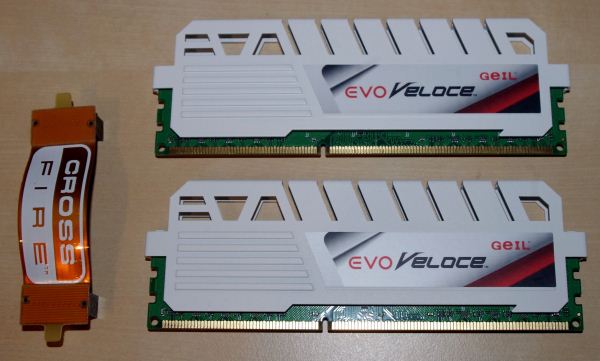
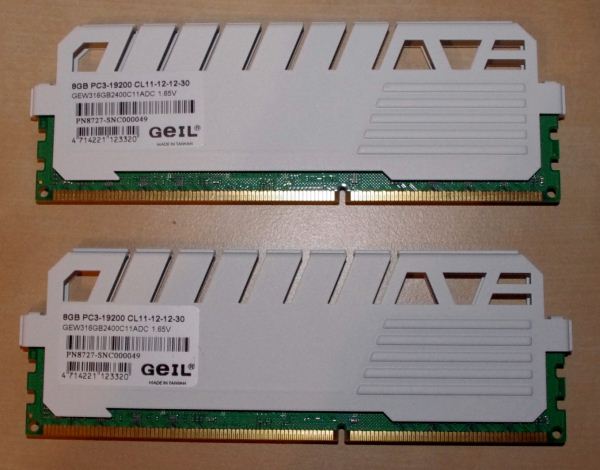



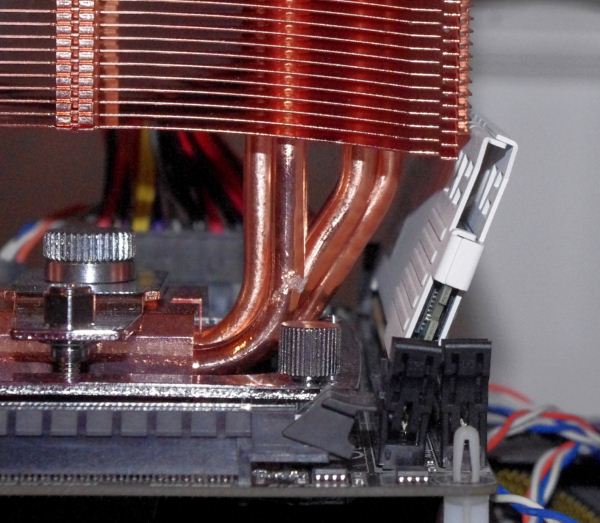















30 Comments
View All Comments
mmstick - Saturday, October 27, 2012 - link
Actually, yes you can tell the difference depending on the applications you run. In fact, the distributed OpenCL GPU computing projects I use over at BOINC, the biological research, requires extreme frequencies. The higher the processor frequency, the higher your GPU load and ability to install more GPUs for the project becomes. If I run my RAM at 1333Mhz with my 7950, I need to run 8 work units in order to get that memory to get 80% efficiency. After overclocking my RAM to 1800Mhz I was able to get the efficiency up to 95%. With faster memory, I could run less work units, and install a second graphics cards, although I would likely need 2133Mhz quad channel memory in order to saturate two 7950s in the HCC project. In POEM, I would actually need 4266Mhz quad channel DDR3 in order to saturate a single 7950 more than likely.Another scenario is AMD APUs, where FPS almost scales linearly based on RAM frequency because it uses system RAM as VRAM. GPUs are very memory intense, which is why GPUs have 256-384 bit memory interfaces. With an APU, the GPU on the die is restricted to the lame 64 bit memory interface we have with our system RAM.
RAM kits like these are sold to people who need them, if you don't need them, buy the lower frequency RAM.
mmstick - Saturday, October 27, 2012 - link
"The higher the processor frequency" I meant "The higher the memory frequency"mmstick - Saturday, October 27, 2012 - link
"to get that memory to 80%" should be "to get GPU utilization to 80%"Impulses - Thursday, October 25, 2012 - link
What's with the cost analysis of all these high speed $150 kits? Would you actually shell out that amount of money for a run of the mill gaming/enthusiast system when there's a ton of 1600 4x4GB or even 2x8GB kits on Newegg selling for $75-85?I've wishlisted like half a dozen G.Skill kits within that range AND with blue spreaders specifically... If I width the search there's tons more obviously, just hoping one of those goes on sale during Thanksgiving for like $50-60, even tho I'm in no dire need to upgrade from 8GB.
(and yeah, looking at blue purely for aesthetic reasons obviously!)
mmstick - Saturday, October 27, 2012 - link
I would because it would cut my research rate in half. I run OpenCL GPU projects on my systems, where if I had 2400Mhz memory I could output twice as many work units with my graphics cards per day in Help Conquer Cancer.n0x1ous - Thursday, October 25, 2012 - link
Green PCB? Really? YukBlack or Nothing
bigboxes - Thursday, October 25, 2012 - link
Do you ever look at your ram once you install it?JonnyDough - Friday, October 26, 2012 - link
That's how I feel. I used to care about the color of my computer case, etc but I realized that its more about longevity and ease of installation for me. It's nice to go with a color theme, but the extra cost each time I upgrade just isn't worth it. So now that I've matured a bit I've decided on mostly black boxes and hardware as its plentiful and price competitive.saturn85 - Thursday, October 25, 2012 - link
how about adding a folding on cpu benchmark?valnar - Friday, October 26, 2012 - link
Memory companies will continue to put out insanely spec'ed pieces so they get reviewed by Hardware sites, because it's the only way to get their name out there. Otherwise, memory as a whole is a pretty boring component. Why else do they also need to have interesting names and brightly colored heatsinks? Marketing at its best (or is it worst?)